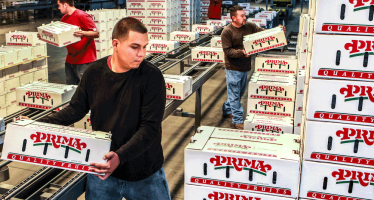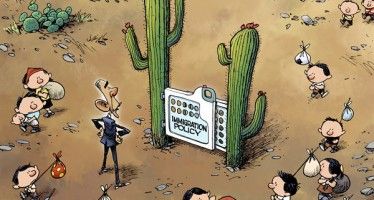Water Keeps CA's Welfare State Liquid
SEPT. 14, 2010
By WAYNE LUSVARDI
Book Review: Running Out of Water: The Looming Crisis and Solutions To Conserve Our Most Precious Resource (Palgrave, 2010).
Mark Twain once wrote: “Denial ain’t just a river in Egypt” using a malapropism on the words “the Nile” (River) and the word “denial.” However, the fictional River of Denial isn’t located in Egypt but in California as reflected in a new book on worldwide water shortages.
Author Peter Rogers, a professor of environmental engineering and city planning at Harvard, and Susan Leal, Harvard-educated former general manager of the San Francisco Public Utilities Commission, have co-authored a book titled Running Out of Water (2010) with the thesis that population growth is leading to worldwide water shortages, especially in California.
While I am not knowledgeable about the water crisis in the Nile River Basin in Eqypt, the Indus River in Pakistan or the Mekong River in Vietnam, all discussed in the book, I am familiar with the water “crisis” in California (although I once almost got shot down in a helicopter over the Mekong River in a war so I do remember it quite well).
Rogers’ and Leal’s book is a compilation of case studies of water shortages in Third World countries (by Rogers) and how technocratic solutions such as recycling urban water and more water efficient farming in California (by Leal) could solve such crises. Rogers’ and Leal’s book could be said to overreach “from the toilet” of the Mekong River “to the tap” of San Francisco (playing on the phrase “from the toilet to the tap” used to describe water recycling).
But more seriously, California isn’t facing a water shortage as much as it is facing a shortage of management of water, land use and taxes. The California State Water Project allocates about the same amount of water today as it did in the late 1960’s when the project was completed (4 million acre feet or 4 million football fields of water one foot deep). But California’s population has gone from about 20 million to 36 million over that 40 year period, an 80 percent increase. Same amount of water but 16 million more people. So much for the water shortage-population growth thesis in Rogers’ and Leals’ book.
In the short term, the California Department of Water Resources does not even project a water shortfall. Instead, it has forecasted that agricultural water conservation will entirely offset urban population demands on water through 2020 (see below):
Projected Change of Statewide Water Use (1995-2020) [million acre feet]
| Year | 1995 | 2020 | Change |
| Urban Use | 9 | 12 | +3 |
| Agricultural Use | 34 | 31 | -3 |
| Net | 43 | 43 | 0 |
| Source: California Department of Water Resources | |||
California is considered a state in perpetual drought. But in 1998 — a wet year — rainfall and imports totaled 335 million acre-feet of water or enough water for 670 million urban households or about 1.675 billion people; or 335 million acres of farming. And 64 percent of this water went to the environment, not farms, not industry not cities nor suburbs. And agriculture and industry, not urban cities, conserved 6.65 million acre-feet of water or enough for 13.3 million urban households or 6.65 million acres of farming. In a dry year in California such as 2001 there were “only” 145 million acre-feet of rainfall and imports, or enough for 290 million urban households or 145 million acres of farming (source: Cal State University Stanislaus). The problem is capture, storage and treatment, not drought, not waste, not necessarily even population or the amount of water by used agriculture.
Fear about a crisis sells books better than knowledge. Rogers’ and Leal’s book is an attempt to scare the public into action and awareness apparently in Callifornia as we can only presume that the political systems of Pakistan, Egypt and Vietnam probably wouldn’t be as responsive to public involvement.
But in California there is a widespread public cynicism about calls for more funding for more and more promised water projects that never materialize for political, not meteorological, reasons. California taxpayers have authorized about $40 billion in bonds for water programs in the past decade and have almost nothing to show for it but a gargantuan but nearly empty new holding reservoir in Southern California, a bunch of environmental studies, a tourist aquarium in Monterey, a brand new but mothballed water museum at the Diamond Valley Reservoir paradoxically located in Riverside County, and water rate hikes spent on water district employee retirement packages to subsidize the deficit in the state retirement system. Water is a way to keep the welfare state liquid.
Proposition 28, an $11 billion water bond scheduled for the November 2010 California election, was scrubbed from the ballot by the governor and the Legislature because of the public’s growing anti-tax mood.
What Roger’s and Leal’s book could have better focused on is educating and pressuring legislators and decision makers rather than the public, which is suffering from “water crisis fatigue.” And just how water much can be recycled anyway when only about 25 percent of California’s water goes to cities; and of that only a fraction can be recycled before it evaporates or runs to the sea? And just how much more tax money can be thrown at promised water projects that evaporate into thin air?
What Rogers and Leal could have done in their book is point out paradoxical population and land use policies that force greater reliance on imported water supplies instead of more sustainable groundwater supplies in non-coastal areas of California. California Senate Bill 375 will divert new development to coastal cities rather than inland suburbs purportedly to reduce carbon footprints and urban sprawl, but also to consolidate political bases and gerrymandered political districts.
SB375 requires regional planning agencies to put into place sustainable growth plans. It will require that new housing development be shifted from the urban fringe, where groundwater resources are more abundant, such as San Bernardino County, to highly dense urban areas near public transit and light rail lines, such as Los Angeles and Pasadena, where local water sources are patchy and often polluted. The environmental intent of SB375 is to reduce auto commuter trips, air pollution and gasoline consumption.
However, the legislation will unintentionally result in more reliance on imported water supplies from the Sacramento Delta, Mono Lake and the Colorado River for thirsty cities along Californiaʼs coastline instead of diverting development to inland areas that have more sustainable groundwater resources.
Denial is a fictional river in California, not Eqypt. And California is in a perpetual state of denial that it is mismanagement, politicization and population policies, not lack of water or money that has resulted in droughts and abandoned farms and stressed environments. But that isn’t likely to be found in all the new recently published books that there is a water crisis due to population growth in California.
Related Articles
Court OKs constitutional challenge to new state law affecting farm industry
SACRAMENTO – A federal appeals court last week has taken the highly unusual step of finding a U.S. constitutional cause
CA legislation, lawsuits shake up immigration law
A series of political and policy moves have dramatically unsettled immigration law in California, both at the state and federal level.
Drug prices latest CA ballot battle
Responding to a growing sense of alarm among state officials and the general public, the AIDS Healthcare Foundation has secured




